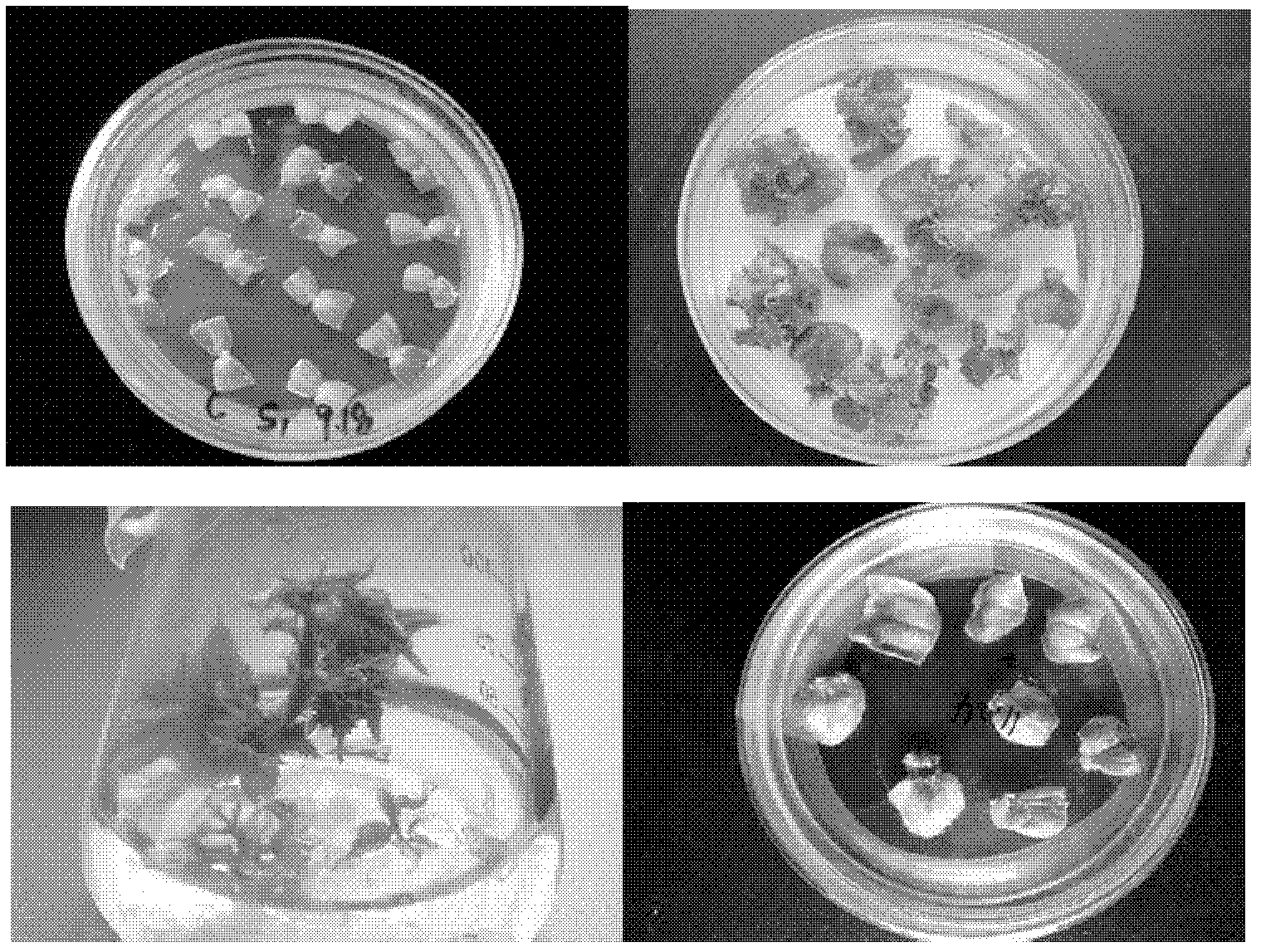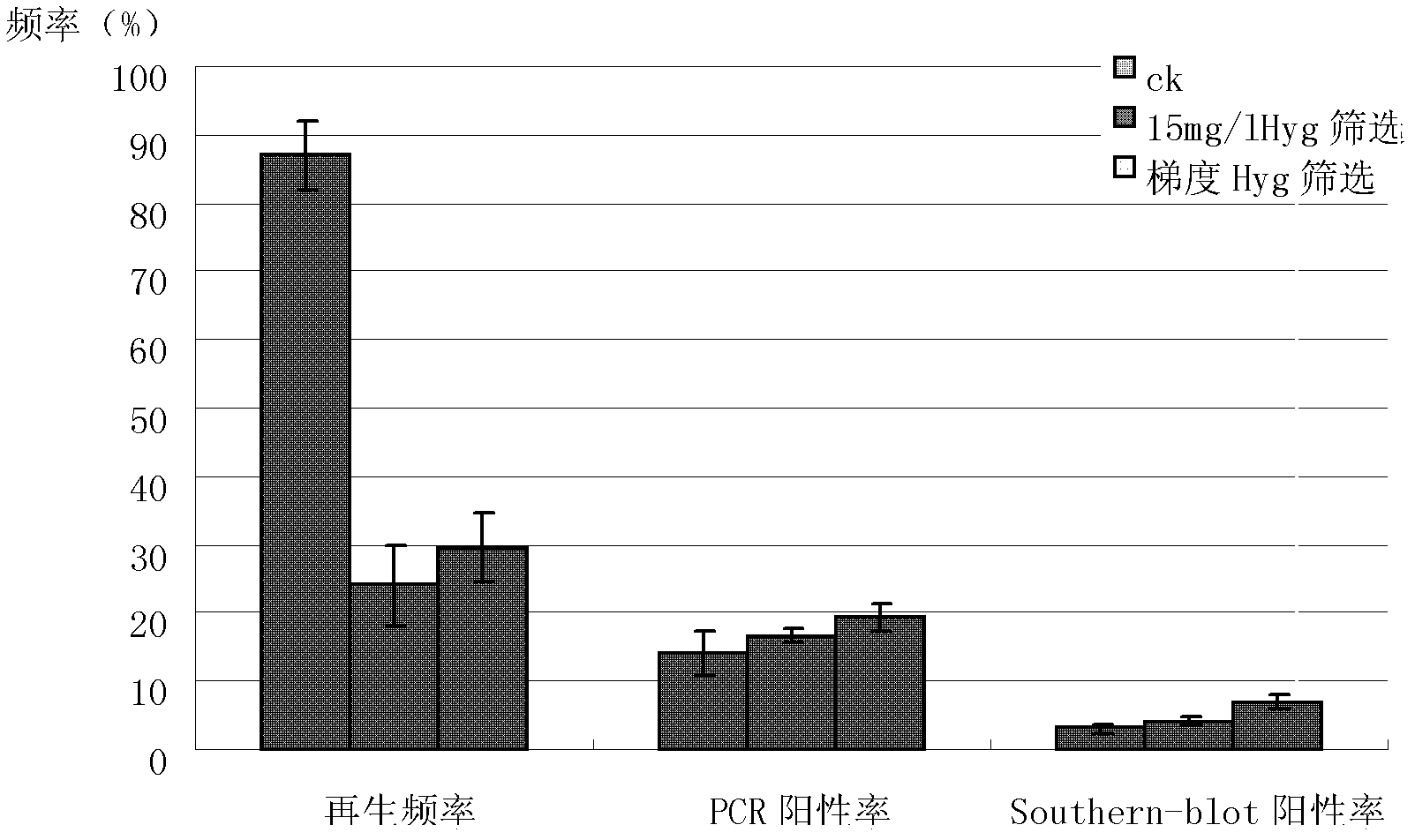Method for introducing RNA (ribonucleic acid) interfering gene resistant to root-knot nematode into cucumber
An RNA interference and anti-root knot nematode technology, applied in the field of RNA interference fragments
- Summary
- Abstract
- Description
- Claims
- Application Information
AI Technical Summary
Problems solved by technology
Method used
Image
Examples
Embodiment 1
[0050] Embodiment 1. Establishment of cucumber genetic transformation method
[0051] 1.1 Explant preparation
[0052] Pre-soak plump cucumber seeds for 2-3 hours, peel off the seed coat and disinfect with 75% alcohol for about 30 seconds, then disinfect with 6.5% sodium hypochlorite for 15 minutes, shake frequently during the disinfection period, and finally rinse with sterilized deionized water for 5 times, Seeds were inoculated on MS medium and cultured in the dark. After the seeds were grown in the culture medium for 1-2 days, the radicle was excised, and the cotyledons were cross-cut into 4 pieces to obtain cotyledon explants. When the cotyledon node is used as the recipient, it should be cultured under light for 4-5 days after the seeds germinate, cut off when the cotyledon is in an upright state, remove 1 / 2 of the cotyledon and only leave a 2mm hypocotyl, and culture it on the pre-medium PM for 2 days stand-by.
[0053] 1.2 Bacteria solution preparation
[0054] Tak...
Embodiment 2
[0075] Embodiment 2 hygromycin is for the impact experiment of transformant selection
[0076] The transformation method is the same as 1.1-1.5 of Example 1, wherein the hygromycin application scheme in steps (5) and (6) is: when the explants are cotyledons, the hygromycin concentrations are respectively 10 mg / L and 25 mg / L. When the explant is a cotyledon node: the concentration of hygromycin is 7mg / L and 15mg / L respectively
[0077] 2.1 Acquisition of regenerated cucumber plants
[0078] Cotyledon explants can develop small buds after about 3 weeks of culture in the primary selection medium. After being transferred to high-concentration antibiotic medium for selection, some false positive regenerated shoots will turn yellow and stop growing. After 1 month of gradient selection, regenerated shoots that always keep green can be obtained. Transfer the regenerated shoots to the elongation medium, and after 2-3 weeks of culture, the normally developed regenerated shoots will g...
Embodiment 3
[0095] Example 3. Effect of Lipoic Acid on Cucumber Genetic Transformation
[0096] The transformation method is the same as 1.1-1.5 of Example 1, wherein the hygromycin use scheme in steps (5) and (6) is: the hygromycin concentration is always 15 mg / L for screening. The addition scheme and concentration of LA and AS were adjusted as shown in Table 3 to obtain 14 treatments, among which treatment 2 is routinely used in the prior art and recognized to have a relatively good effect.
[0097] Table 3 Concentration ratio of LA and AS during infection
[0098]
[0099] 3.1 Regeneration process of cucumber cotyledon node resistant buds
[0100] Before seeing the light, the color of the cotyledon nodes cut from the seedlings remains light green, and it does not begin to darken until it is cultivated under the light, and the volume of the cotyledon nodes increases obviously after seeing the light, and the leaves thicken. About 1 week after inoculation, a small amount of callus be...
PUM
| Property | Measurement | Unit |
|---|---|---|
| concentration | aaaaa | aaaaa |
Abstract
Description
Claims
Application Information
 Login to View More
Login to View More - R&D
- Intellectual Property
- Life Sciences
- Materials
- Tech Scout
- Unparalleled Data Quality
- Higher Quality Content
- 60% Fewer Hallucinations
Browse by: Latest US Patents, China's latest patents, Technical Efficacy Thesaurus, Application Domain, Technology Topic, Popular Technical Reports.
© 2025 PatSnap. All rights reserved.Legal|Privacy policy|Modern Slavery Act Transparency Statement|Sitemap|About US| Contact US: help@patsnap.com



